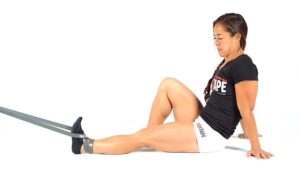by Mitch Hauschildt, MA, ATC, CSCS
The hips are often problematic with our patients, clients and athletes. They tend to be tight and restricted, even though the joint is designed and intended to have a very large range of motion. This is ultimately because a lot of people are unstable in other areas of the chain, so they constantly steal stability from their hips. This leads to a hip restriction. Thus, the underlying cause of many mobility problems is a lack of stability. But, we also understand that if we don’t have mobility, we will never have true stability. So, we must train mobility first and then follow it up with stability training to repattern the nervous system. You can learn more about this relationship in my free ebook on mobility training.
I am constantly exploring ideas and ways to improve hip mobility. I utilize hands on mobilizations and stretching, self stretching techniques, and interventions that involve bands and weight. One technique that I have used on and off over the past couple of years is using long axis traction of the lower extremity to open up the hip joint.
When we understand that mobility is primarily a nervous system response, we understand why traction can be an effective technique. Oftentimes, the brain locks down a joint because it feels threatened by movement.
When the brain is threatened, it is performing
A great way to decrease the threat to the brain is to distract the joint to relieve pressure and send a signal to the brain that it has no reason to feel threatened. When that happens, mobility gains tend to be made rather easily.
Recently, I have added a twist, both literally and figuratively, to a standard lower extremity traction. We use a strong band to distract the joint and provide long axis traction. We can hang out there and work on mobility by simply relaxing the tissue around the joint and opening it up. In addition to that, once they have relaxed, we can grasp the foot and distal thigh and begin to rotate the leg into their restriction (either internal or external rotation). I find that performing rotation while under this tension, we are get a more pronounced and longer lasting hip rotation mobilization than with many of the passive stretching and mobilizations that I have used previously.
I prefer to perform this technique both in neutral position and in multiple degrees of hip abduction and flexion. Every time we move the leg into a different position, we change the feedback to the brain and this allows us to improve mobility in a more comprehensive manner than just doing it in 1 or 2 planes of motion. It also allows us to find those areas in between that tend to exist that we doing work on very often and go after them.
Check out this video to see how I utilize this technique.
Overall, there are a number of techniques for improving mobility and what is right for each patient, client or athlete is different for everyone. That’s why I like to have multiple tools in my toolbox and this is another tool that I hope you try and enjoy as much as I do.


Thank you for the explanation on this technique. I’ve always been curious on how this work and the different ways to do it. My chiropractor does this to me all of the time to help with my tight QL.